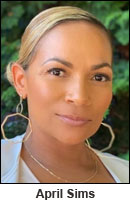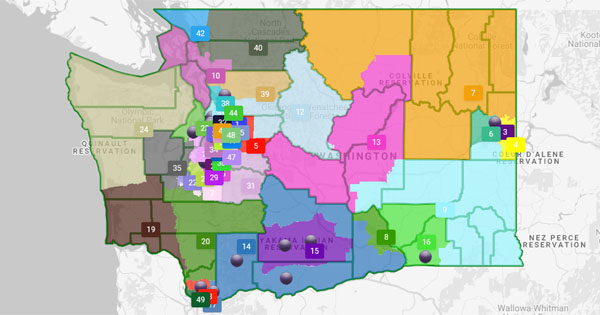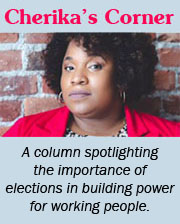OPINION
Redistricting shapes our political landscape
Redistricting Commissioner April Sims explains why drawing the maps is so important to working people
By CHERIKA CARTER
(Oct. 8, 2021) — It is time to #DrawTheMaps. All over the country redistricting is happening and new electoral maps are being drawn. Redistricting occurs every 10 years following the decennial census. The redistricting process is the procedure of redrawing voting district boundaries. District boundaries have a profound ability to shape which communities and interests have a voice in our government, which is the reason why redistricting so important.
Check out this short video describing redistricting.
While redistricting is happening everywhere, it looks different in every state. Here in Washington, we have an independent Redistricting Commission. The commissioners are charged with creating legislative and congressional districts to reflect changing populations and demographics in our state. This process was adopted in 1983. The commission consists of four members appointed by the respective leaders from the two largest parties in each chamber of the legislature. The four commissioners appoint a fifth nonpartisan, non-voting chair. Additionally, commissioners may not be registered lobbyists or have served in elected office in the past two years.
Luckily for Washington’s labor movement, our very own WSLC Secretary-Treasurer April Sims serves as one of the four voting commissioners. Sims is phenomenal in all that she does and has dedicated her professional life to building power for working people, bringing communities together, and advancing racial and economic justice. Who better to serve and be sure Washington’s working families have a voice in our government?
 Recently I had the opportunity to sit down with Sims and ask her a few questions regarding redistricting. Here’s a snippet of our conversation:
Recently I had the opportunity to sit down with Sims and ask her a few questions regarding redistricting. Here’s a snippet of our conversation:
Cherika Carter — You’re the first person of color to serve as a redistricting commissioner. How has this awareness of the lack of representation influenced your work?
April Sims — It’s impossible to separate myself from my community, and as the first person of color serving on the redistricting commission, it is both a privilege and a responsibility to bring the voice and values of my community into the process, and make sure that they are articulated in the maps.
CC — Can you speak to how your lived experiences as a Black woman, a working-class woman, and a union member has helped shape your perspective as you do this work?
AS — It’s really exciting because I’m not just the first Black woman appointed to the commission, I’m also the first person appointed from labor. One of the things about the Redistricting Commission is that it determines what our government looks like, and a government that looks like the people it represents is a powerful thing. So drawing boundaries that allow communities of interest to elect people from their communities will bring those community values into the halls of power, which is impactful and powerful. Working people care about transportation, being able to afford to live in the communities they work in, health care, accessible and affordable child care. And these are just a few issues that are top of mind for me. All of these issues are impacted by policies from elected officials. So being able to elect folks who care about working family issues in the same way that working people care about them is absolutely important. It is one of the WSLC’s theories of change and a way we build power for working people, by supporting elected leaders who will champion strong worker policy that lifts up all working families.
CC — What were your guiding principles when designing your maps?
AS — When drawing my maps and doing the work to rebalance our state’s 49 legislative districts and 10 congressional districts, I was guided by these four principles:
- Protecting fair and effective representation
- Maintaining and creating communities of interest
- Respecting Tribal sovereignty and the government-to-government relationship with Tribal partners
- Centering and engaging communities that have been historically underrepresented
And it is my hope that the final maps put forward by the commission will be a reflection of those values.

(You can find and view Sims’ proposed legislative and congressional maps.)
CC — Based on your interactions with your fellow commissioners, are you optimistic that you will be able to come up with a map that has the support of three of four commissioners and avoid sending the issue to the Washington State Supreme Court?
AS — Absolutely. It seems like we’re far apart, but we have a job to do. All of the commissions in the past have been able to get their work done. I am 100 percent optimistic that we’ll get the job done. All of us will need to listen to public input and follow the charge of the commission — which is to draw maps that reflect the political reality of our state, and not maps that engineer election outcomes — and not just focus on one goal, especially when the actual goal and the law isn’t reflected in the proposed maps of some of my colleagues. I’m not willing to abandon the charge of the constitution, the statute or my values that I brought into this process. This is the most diverse commission in the history of our state and we all have a vested interest in producing the final maps that will represent the people. And at the end of the day, I believe we will get it done.
CC — Finally, why is the redistricting process so important for working people? What’s at stake?
AS — These maps will determine the political landscape of our state for the next decade, and that is what’s at stake. That is potentially 10 years of good policy for working folks. Ten years of policies that allow families the dignity that comes from working for a better life and being able to take care of family. Ten years of policies that strengthen the social safety net. Ten years of policies that lift families out of poverty, and prioritize affordable housing and child care. These maps will be in effect for the next decade. So, what we do today will have consequences far beyond the short period of time that our commission is charged with doing this work.
The redistricting process is important and as Commissioner-Administrative-Law-Judge Secretary-Treasurer April Sims laid out, there is a lot at stake for working people and all of us should participate. Here are five ways you can participate now:
1. Share information with the commission about your community. The commission welcomes information and insight about communities and what makes them whole. Hearing from community helps them draw the best maps possible. You can share your insight here.
2. Draw your own maps. Share you maps and ideas about community boundaries with the commissioners. You can draw maps here.
3. Share your comments on the proposed maps at the last public outreach meeting. The commission will hold its last public meeting before finalizing the maps, Saturday, Oct. 9 at 10 a.m. You can sign up here.
4. Provide written feedback to the commission. In addition to Saturday’s meeting, you can also provide written feedback to the commission here.
5. Join in on the conversation on social media. Use the hashtags #DrawTheMaps and #DrawYourWA to talk about redistricting, and be sure to follow the WSLC on our socials.
![]() @WAaflcio
@WAaflcio ![]() @wa_aflcio
@wa_aflcio ![]() @WAAFLCIO
@WAAFLCIO
 While Knocktober is my favorite time of year, and the added excitement around the new districts has me feeling like a kid in a candy store, over the next few weeks we have some real opportunities to continue to build power for working people beyond just redistricting. Contact your local Central Labor Council today and sign up for a Labor Neighbor shift to help get labor champions elected to office and get out the labor vote!
While Knocktober is my favorite time of year, and the added excitement around the new districts has me feeling like a kid in a candy store, over the next few weeks we have some real opportunities to continue to build power for working people beyond just redistricting. Contact your local Central Labor Council today and sign up for a Labor Neighbor shift to help get labor champions elected to office and get out the labor vote!
Cherika Carter is Political and Strategic Campaigns Director for the Washington State Labor Council, AFL-CIO.





